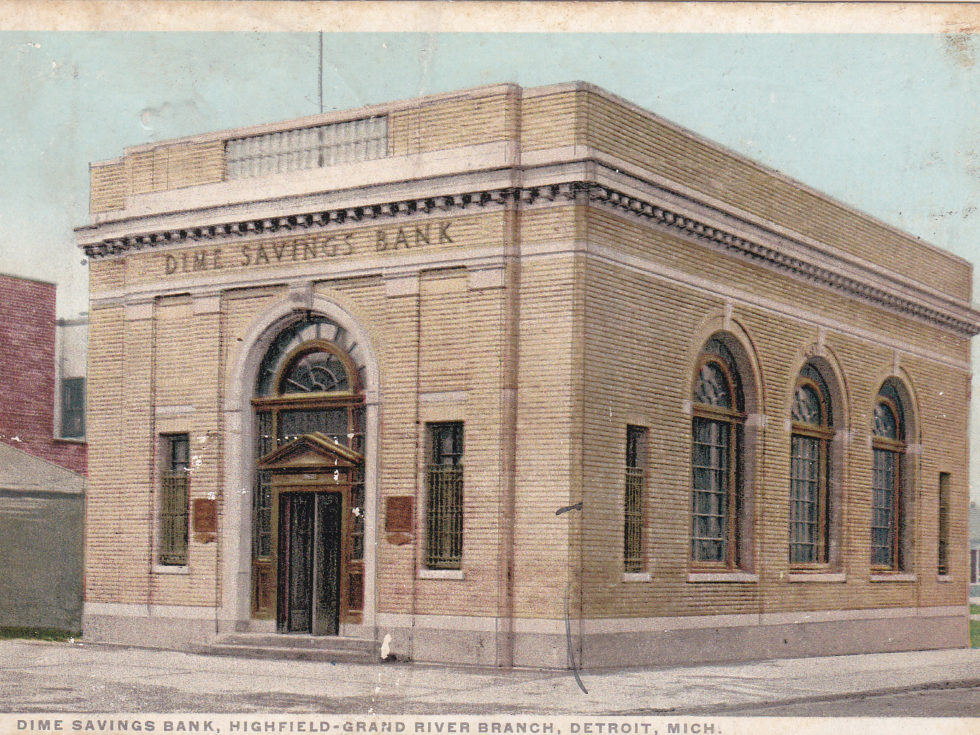
Passion For Genealogy is reader supported. When you use and buy through links on this site, we may earn an affiliate commission.
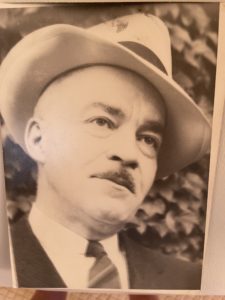
This Michigan genealogy story shares inspiring moments during the Great Depression in Detroit.
Sometimes while researching your ancestors there is one individual who seems to scream out for your attention. As you rummage through vital records, letters from family members, old newspapers and other such memorabilia that one person seems to linger longer in your thoughts almost saying “pick me, pick me.” My great grandfather, Rufus Adolphus Joseph Somers was that individual and one of my favorite family members to research. Because of his colorful past I was fortunate to have been left clues to his personality and life story.
Table of Contents
Research Begins for Michigan Genealogy on Dick Somers
To begin with Rufus was known by family and friends as Dick Somers. I have no idea how this name came into play, but perhaps he disliked the name Rufus and chose a more popular name for that period. Rufus or Dick Somers was born on the August 28, 1885, in London, Ontario. His parents were Duncan Somers and Nellie Myers.
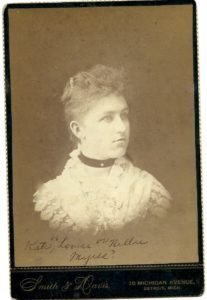
He had an older sister, Gertrude Delores, who was born Mar 21, 1883. Both Rufus and his sister early in life chose to use an alternative spelling of their last name. Soon after Rufus’s birth, his father deserted his family to pursue his own interests as a musician and lothario. To my knowledge, Rufus never saw his father again. After the disappearance of Duncan, Nellie struggled to make ends meet without much success.
Times were hard for the young mother and she soon realized that she needed to ask her parents for support. Adolph Myers and his wife, Catherine Woods lived nearly 75 miles away in the farming community of Raleigh Township, Ontario. Both were hardworking devout Roman Catholics who had immigrated to Canada from their native countries. It was clear that they wholly disapproved of their daughter’s choice in spouses.
The Early Years in Ontario
According to the Ontario marriage records, Nellie and Duncan were married in London, Ontario by a Justice of the Peace on April 13, 1882. It is unclear how Nellie originally meets Duncan, but it is apparent that if her family approved of the relationship their marriage would have been celebrated in the Catholic Church along with family and friends rather than alone in a court house with no familiar witnesses.
Soon after the disappearance of Duncan, Nellie and her two children moved to the Myers farm. Her father, Adolph was born in Lohr, Bavaria in 1827. As a young man he immigrated to the United States then continued to Kent County, Ontario where he took up farming, during the mid-1850s. His wife, Catherine was born in Limerick, Ireland and as a young girl traveled to Canada to escape the devastating effects of the Great Famine and improve her station in life.
In the Ontario census records for the years 1891 and 1901, Rufus and his sister are recorded as residing with their grandparents. Their mother, Nellie is not listed as a resident of their household. It is only speculation to conclude whether or not she was asked by her parents to contribute to household finances by the way of a position outside of their home.
During the years of 1887 and 1896, Nellie is enumerated as living alone, according to the directory for the city of Detroit. Her addresses vary over the years as she moves to assorted boarding houses. Nellie’s occupation continues to remain the same as she is listed as a capsule maker in all directories. As Detroit was the closest large city to her parent’s home, Nellie had a better opportunity to find a job as an unskilled laborer. After obtaining work, her visits with her young children became a lot less frequent.
In a copy of a letter to an insurance company by Rufus on February 06, 1948, he states that “he lived with his mother and sister in Detroit, the last address he remembers was in a room at 80 Beech Street. Later he was taken with his sister to Chatham, Ontario; to his grandfather’s home from whom he attended both separate school and high school, the latter he passed to when he was 12 years old. He left Chatham when he was 14 years of age and supported himself…”
In the same letter he continues, “that to the best of his knowledge and belief that he was born August 28, 1887, that his first remembrance of any important event was the seeing of a railroad engine with gilded stripes, said engine, he was told was on its way to the Chicago World’s Fair of 1893.” In reality, his birth year is listed in the Ontario census records for the years 1891 and 1901, as 1885. In addition, his U.S. World War I Draft Registration card gives his birth date as August 28, 1885. It appears that Rufus may have tried to convince the insurance company that he was a bit younger claiming he was 61 years old instead of 63.
By the time of the 1901 census, Adolph, his daughter Louise, and two grandchildren have moved from their farm in Raleigh Township to the small hamlet of Chatham. The Myer’s farm is now being run by Adolph’s two sons with their older sister, Nellie keeping house. It is uncertain why Nellie has returned from Detroit to join her siblings back on the family farm. Rufus and Gertrude continue to live with their grandfather and find city living to be much more conducive to their life style.
Married Life
After arriving in Chatham, Rufus meets his future wife, Grace Pearl Darling. The 1891 Ontario census lists Grace’s family residing on the same street as the Myer’s household. Grace, a lovely young girl of Scottish descent was three years younger than Rufus. Both individuals had similar personalities being extraverts who loved people and life in general.
On September 15, 1905, Rufus and Grace were married in Windsor, Essex, Ontario by a Justice of the Peace. It is unknown whether any family members attended their wedding. Again religion may have been an issue with the couple’s reasoning for marrying outside of their community. Rufus being raised by his maternal grandparents was a Roman Catholic while Grace was brought up in the Protestant faith. Two years later the couple remarried on the 21st of May 1907 in the Our Lady of the Rosary Catholic Church in Detroit, the same day as Grace is baptized as a Roman Catholic.
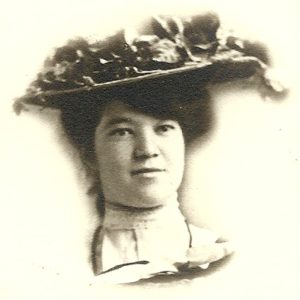
After their marriage in 1905, the young couple moved to Detroit where Rufus had more opportunities for better employment. From 1905 to 1914, Rufus tried his hand at different positions. He became a successful realtor, bookkeeper, and salesman. Due to his likeable personality and his go-getter attitude he was a success in most things that he attempted.
As World War I began, the U.S. economy was in a recession. Although Rufus had a positive attitude, times were rough for the young family. Jobs were scarce in the city, so Rufus came up with another alternative plan. He decided to pack up his family and homestead in Alberta, Canada. This new venture most likely came from his wife’s, side of the family. A
round the beginning of the war, Grace’s father, Thomas Darling decided to take advantage of the Dominion Land Act which had been in effect for many years. The Canadian government offered individuals and families an opportunity to own 160 acres or a quarter section of land in the Western provinces. The stipulation was a ten dollar registration fee, live on and cultivate the land, and stay on your homestead for a certain amount of years.
Returning Home – Detroit Michigan Genealogy Research
In 1914, Rufus, Grace, and their three children packed up and made the journey to the wilds of Alberta. During the two and a half years spent in the foothills of the Rockies, Rufus had a wonderful time playing rancher. He had always enjoyed nature, especially hunting and fishing so this new way of life suited his lifestyle perfectly. In later years, his children reminisced with fond memories about the rugged times living off the land, riding horses, and raising cattle. To Rufus and the children it was a great adventure, but Grace was more realistic. According to her, it was time to return to reality, and to Detroit.
After his Canadian sojourn he resumes his career as a salesman for the Simons Sales Company in Detroit. He excels in his job but is laid off while attempting to sell Cleveland Tractors and White trucks in a down economy. Per a recommendation letter from his former employer he states, “We are sorry that we have to discontinue his services, along with twenty-five other salesmen who we have had in our employ, on account of shortage of automobiles and non-production at the factory.” The year 1918 was the beginning of a short- term, post-war recession which lasted only a couple of years.
Detroit Bank Manager
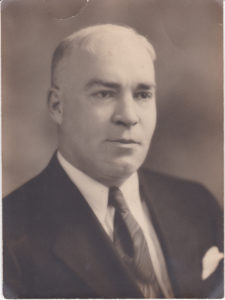
In 1922, Rufus would land the job of his career. He was hired as Branch Manager for the new Dime Savings Bank at the corner of Joy Road and Grand River Ave in the Northwest section of Detroit. This area of Detroit in the early twenties was still very rural-Joy Road was first paved in 1922.
Dick, as he now preferred to be called, felt that the Northwest section of Detroit needed additional businesses to help grow and serve the community. He began communicating with potential companies offering them banking assistance if they would consider opening stores in his area.
By 1925, he organized the Northwestern Business Men’s Association, an organization, “to stimulate and encourage, buying and trading in the Northwestern section of Detroit.” One of the first businesses he conveyed to the area was the Sanders store of the ice cream soda fame.
According to the, “Detroit Times” newspaper, dated December 29, 1929, “He approached John Miller, head of the stores, and urged him to consider the advantages of the Grand River –Joy road intersection. Miller finally was persuaded to locate at the intersection and Somers, like other leaders in the area, believes that was “the real start” and spur for the northwest section.” From that point, property values increased. By the start of 1929, real estate values jumped from $300 a foot to $6,000-a-foot in Northwest Detroit.
The Great Depression Hits
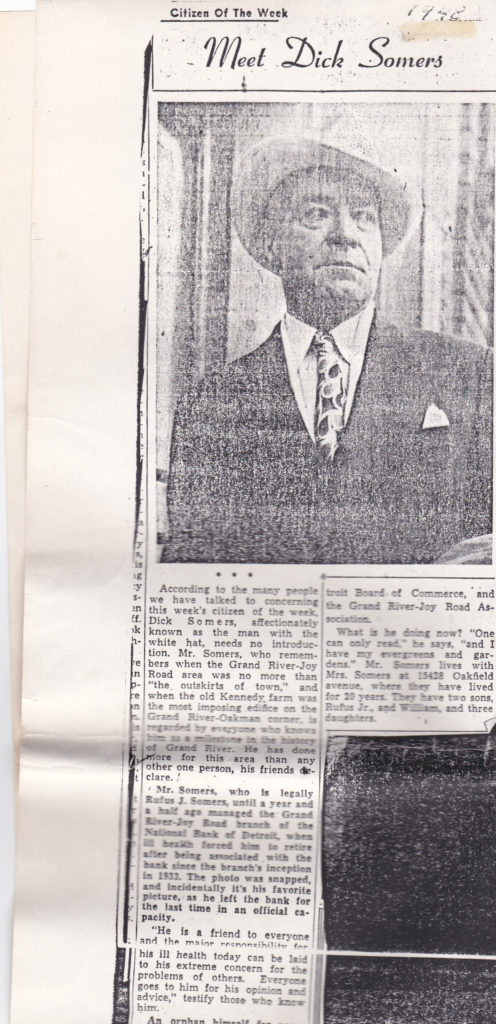
As the Great Depression hit most areas of the United States, he projected confidence toward the business conditions in Detroit. The front page story of the March 06, 1930 edition of the- “Detroit Tribune” reads “Predicts Record Year” with a subheading “Banker Optimistic Toward Conditions” The article reads, “I’m optimistic,” declares Dick Somers, “we all are.”– “But I want to say, that conditions are slowly changing for the better. Any sensible person knows that it requires more than two or three weeks to recover from business sluggishness as great as we have been confronted with this winter.”
Another article from the same paper and date under “The Weekly Interview” section gives a portrayal of Dick’s work ethic. He is described as a gentleman banker who goes out of his way to take care of his customers on a personal note. Everyone that enters his bank gets his undivided attention whether it is a greeting, listening to someone’s problems, or engaging in the latest story, no patron goes without notice.
Although, his banker’s duties are plentiful, his interaction with his customers are the reason his bank is one of the most successful in Detroit. In a local bank publication,- “Enbeedee,” its “Personality Portrait” column explains Dick Somers’s success as banker; “Hardly a customer comes into the bank that doesn’t stop for a word with Dick or an exchange of stories-his fund of these is practically inexhaustible. What’s more he can call almost all his customers by name and is privileged to chuck nice old ladies under the chin any time. He’s father confessor to the whole community!”
As many financial institutions went out of business, Dick Somers’s depositors remained untouched. As the Depression continued throughout the 1930’s, he continued to stimulate growth in his region all the while looking after his customers’ best interests.
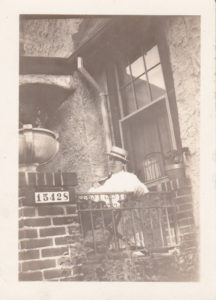
The Trademark White Hat
Throughout his personal life Dick Somers was somewhat of an eccentric. Since 1922 he wore daily a white hat or fedora cocked a little to the left side of his head. It was his personal trademark. It didn’t matter what kind of weather, the famous fedora was always in place. He once explained to a newspaper columnist that he began wearing white hats as he likes clean, and white represents cleanliness.
He also built the first all-white bathroom in his Detroit home. According to reporter, Vera Brown from the- “Detroit Times” in her February 11, 1947 article she comments on his all-white bathroom; “Housewives who saw it, circa 1916 almost swooned. Declared they would never have such a thing in their homes. Too hard to take care. That’s the kind of pioneer Dick is. ” He also found electronics especially fascinating. By the early 1920’s he had one of the first voice recording machines in his home. Any product that was new or different was met with his great enthusiasm.
Later Years – Michigan Genealogy Story
By 1948, Rufus Somers took an early retirement from this beloved bank due to health issues. National Bank of Detroit had replaced the Dime Savings Bank some years past, but regardless of the name change Dick Somers continued to know the needs and wants of his community.
The man in the white hat was a symbol of hope during Detroit’s Depression years, and worn by Dick, the most optimistic banker in Detroit. During his tenure as bank manager he managed to energized and strengthen Northwest Detroit in one of its most troubled times. Due to his guidance, new businesses appeared while other sections of Detroit struggled to remain alive.
While many banks failed, his depositors remained unscathed. Everyone knew the man in the white hat who could be relied on for sound advice and unbiased opinions. But as for me, my great grandfather Rufus or Dick Somers will always be the ultimate hero, for why else would he wear a white hat?
Michigan Genealogy Research Continues…
I hope you enjoyed my family Michigan genealogy research story. If you enjoyed this article, please check out a few others found at this links below.

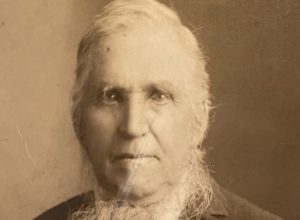
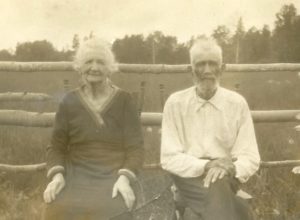



March 22, 2022
Colleen,
You have a very entertaining style of writing!
I enjoyed The Man in the White Hat.
Thanks